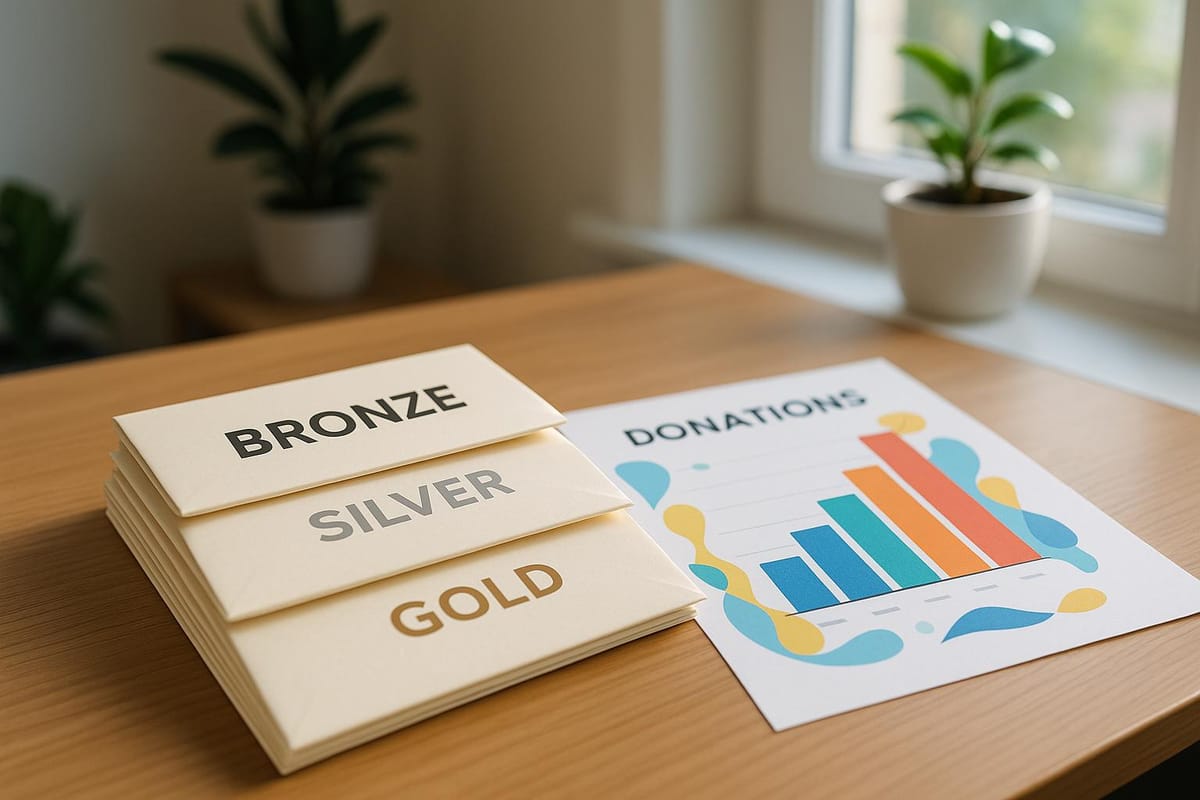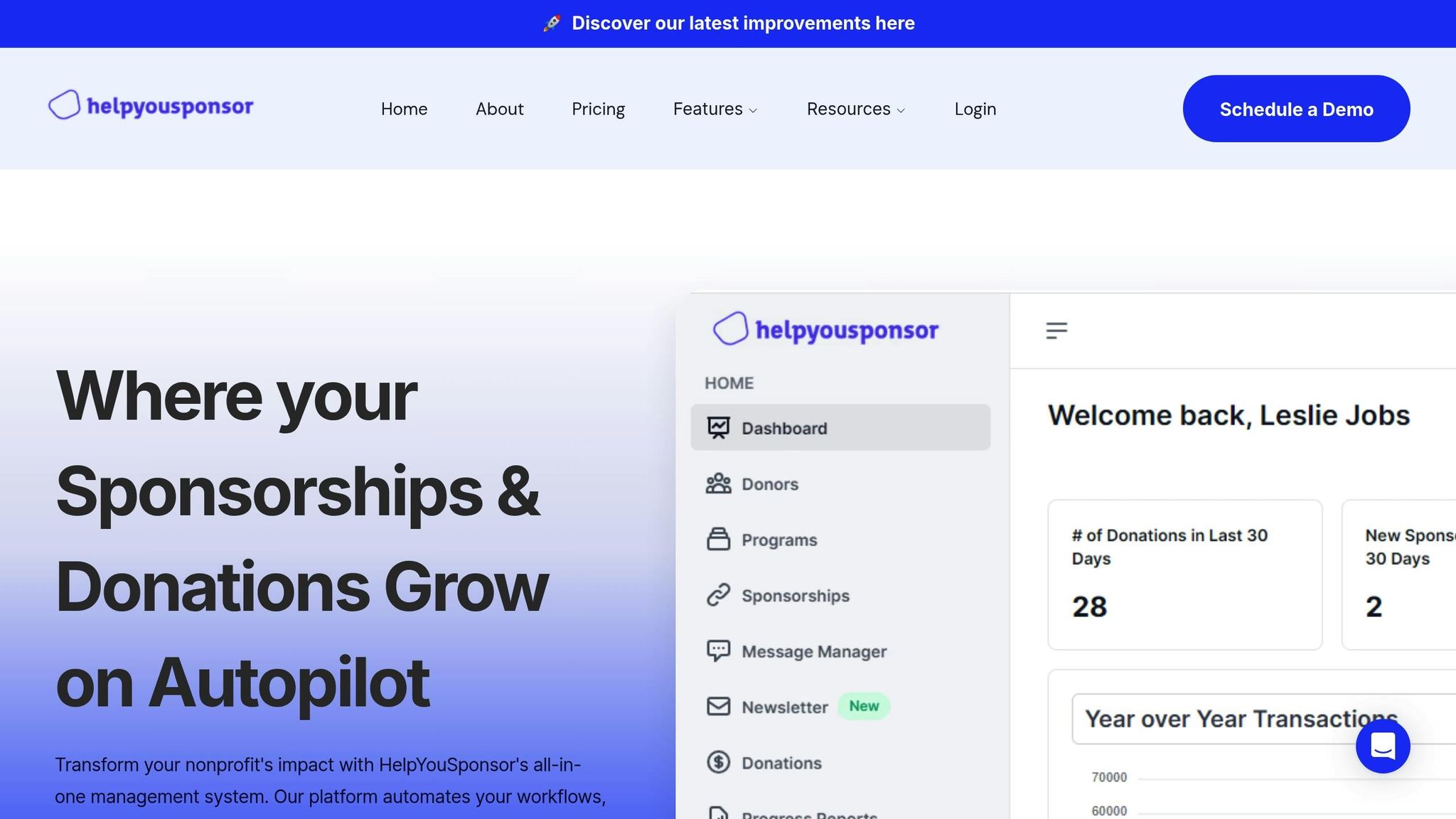Donor Tiers: Examples and Best Practices
Explore how donor tiers can enhance nonprofit engagement, streamline recognition, and cater to diverse donor preferences through modern tools and traditional methods.

Donor tiers help nonprofits recognize contributions and inspire donors to give more. They organize supporters into levels based on donation amounts, offering benefits like newsletters, events, or personalized messages. While traditional systems rely on manual tracking, modern tools like HelpYouSponsor automate most tasks, saving time and reducing errors. The choice between manual and automated systems depends on your organization’s needs and donor preferences.
Key Points:
- Donor Tiers: Structured levels to categorize donors based on contributions.
- Benefits: Boost donor loyalty, retention, and average gift size.
- Traditional Systems: Manual tracking with physical rewards like plaques or event invites.
- Automated Platforms: Tools like HelpYouSponsor streamline tier management with features like real-time tracking, automated receipts, and scalable pricing starting at $50/month.
Quick Comparison:
| Feature | HelpYouSponsor | Manual Systems |
|---|---|---|
| Setup Time | Fast, automated | Time-intensive, manual |
| Maintenance | Minimal, automated updates | High, manual updates |
| Recognition Speed | Instant digital acknowledgments | Delayed, physical materials |
| Cost | Usage-based, scalable pricing | Fixed, higher with growth |
| Donor Preference | Digital-first donors | Supporters valuing tradition |
The best approach balances donor preferences with your resources. Automated tools work well for tech-savvy donors and growing organizations, while combining digital and manual methods can cater to a broader audience.
Tiering Your Donors: The Ultimate Caseload Management Strategy
1. HelpYouSponsor

HelpYouSponsor simplifies donor tier management by automating tasks that would usually require manual effort. This platform redefines how organizations design, recognize, and expand their donor recognition programs with its suite of automated tools.
Tier Structuring
With HelpYouSponsor, nonprofits can design flexible tier structures that suit any donation model. The platform allows organizations to create custom tiers, each with specific donation thresholds, benefits, and recognition criteria. Whether managing child sponsorships, building projects, or medical fundraising campaigns, nonprofits can run multiple tier systems simultaneously.
By categorizing donors based on their contributions, the platform eliminates the risk of misclassification. This organized system ensures smooth donor engagement and recognition.
Recognition Methods
Acknowledging donors becomes effortless with HelpYouSponsor's automated features. The platform sends personalized, tier-specific messages and receipts to ensure every donor feels valued.
Organizations can tailor recognition methods for each tier. For instance, smaller contributions might receive simple email acknowledgments, while major gifts could be met with more personalized messages. The integrated messaging system also supports targeted outreach, aligning recognition efforts with each donor's contribution level.
Ease of Implementation
Despite its advanced features, HelpYouSponsor is designed to be user-friendly. The setup process is straightforward, with an intuitive interface guiding organizations every step of the way.
The platform also makes it easy to integrate donor tier benefits into a nonprofit's website. Plus, it supports multiple payment processors through seamless payment gateway integration.
Scalability
HelpYouSponsor’s pricing model is built for growth. Instead of a flat monthly fee, organizations pay based on active commitments. For smaller operations, there’s a free plan covering up to 10 commitments per month. As donor numbers grow, paid plans start at $50/month, offering a cost-effective solution.
The platform adapts as donor loyalty increases, effortlessly scaling to handle higher volumes and more complex tier structures. It also provides detailed donation tracking and reporting tools, making it suitable for organizations of all sizes looking to maintain personalized engagement as they expand.
2. Standard Donor Tier Systems
Nonprofits often lean on long-established methods to organize and manage their donor recognition programs. These tried-and-true approaches have been around for decades, offering a sense of familiarity and tradition. However, they typically require a great deal of manual effort, which stands in stark contrast to the streamlined efficiency of automated platforms. While these systems hold historical significance, they come with their own set of modern challenges.
Tier Structuring
Traditional donor systems commonly follow a pyramid model, with clearly defined levels based on annual donation amounts. At the base, you find supporters giving smaller contributions, followed by mid-level donors who give more, and finally, major donors at the top, contributing significantly larger amounts.
Some organizations tweak this model by using percentage-based thresholds instead of fixed amounts. For instance, they might design their system so that most donors fall into the lower tier, a smaller group into the middle, and only a select few into the highest tier. While this approach allows for flexibility as donor demographics shift, it often requires regular recalculations to keep the system aligned with changes.
Economic factors also play a role. Nonprofits operating across diverse regions may adjust their tier thresholds to reflect local economic realities. For example, thresholds in urban areas might differ significantly from those in rural communities or between states, ensuring the system remains relevant to the donor base.
Recognition Methods
Once the tiers are established, nonprofits use various methods to recognize donors, with practices tailored to each level. Annual reports often list donors by tier, giving those in higher brackets more prominent placement. Newsletters, donor spotlights, and appreciation events - ranging from casual meetups to formal galas - are common ways to express gratitude.
Naming opportunities are another popular form of recognition. For example, a children’s hospital might offer donors the chance to name a room, wing, or piece of equipment, with larger contributions tied to more prominent naming rights.
Additionally, many organizations provide tangible tokens of appreciation, such as plaques, certificates, or branded merchandise. These items, often personalized with the donor’s name and tier, serve as lasting reminders of their contributions and typically feature the nonprofit’s logo.
Ease of Implementation
Setting up and maintaining a traditional donor tier system requires significant coordination across teams. Staff must track donations, update records, and ensure timely recognition for contributors.
Smaller nonprofits may rely on spreadsheets or basic donor management tools, which involve manual data entry and frequent updates. While this setup might work for organizations with a modest donor base, it becomes increasingly burdensome as the number of donors grows.
Recognition materials also go through a multi-step approval process. Marketing teams handle design, development staff verify donor details, and leadership provides final sign-off. This layered approach, while thorough, can introduce delays and add complexity to the process.
Scalability
As nonprofits grow, traditional tier systems often face scalability challenges. Managing a larger donor base with manual processes can lead to time delays, which may ultimately affect donor satisfaction and retention.
Costs are another concern. Expenses for printing and mailing materials, hosting events, and maintaining physical displays increase as the donor base expands. Organizations must find a balance between acknowledging donors appropriately and staying within budget, a challenge that becomes more pronounced as resources are stretched thin.
Pros and Cons
When deciding between HelpYouSponsor and traditional donor management systems, nonprofits must carefully consider factors like efficiency, cost, and donor engagement. Each approach has strengths that cater to different organizational needs and donor expectations.
HelpYouSponsor simplifies donor management by automating tier categorization and recognition. Its pricing model is usage-based, starting with a free plan for up to 10 commitments and scaling as donor volumes grow. This ensures organizations only pay as they benefit from the platform's features, making it a cost-effective solution for growing nonprofits.
On the other hand, traditional donor tier systems have their own appeal, especially for certain long-standing supporters. Many donors value tangible recognition methods like printed annual reports, formal galas, or physical plaques. These approaches can evoke a sense of tradition and permanence that digital communications sometimes lack.
Here’s a quick comparison of key operational differences:
| Feature | HelpYouSponsor | Traditional Systems |
|---|---|---|
| Setup Time | Quick and automated configuration | Requires a more time-intensive manual setup |
| Monthly Maintenance | Minimal, with automatic updates | Significant staff effort for manual updates |
| Recognition Speed | Instant digital acknowledgments | Delayed due to production and mailing |
| Cost Scaling | Usage-based pricing that grows with success | Fixed costs, regardless of donor growth |
| Customization | Digital templates with options for edits | Fully personalized physical materials |
| Donor Preference | Appeals to tech-savvy, digital-first donors | Preferred by those who value traditional methods |
Traditional systems often require increasing manual effort as donor bases grow. This includes tasks like tracking contributions, coordinating recognition, and covering the rising costs of printing and mailing physical materials. These fixed costs can become burdensome for nonprofits with expanding donor pools.
By contrast, HelpYouSponsor offers a more scalable solution. Its integration with payment gateways allows for real-time donation tracking, streamlining the process for both organizations and donors. Automated updates and instant acknowledgments enhance operational efficiency while catering to modern, digitally engaged audiences.
Ultimately, the decision between an automated platform like HelpYouSponsor and traditional donor management depends on the nonprofit's goals and its donors' preferences. Organizations with tech-savvy supporters may prioritize automation and efficiency, while those with a history of long-term relationships might find value in blending traditional methods with modern tools. This balance allows nonprofits to tailor their approach to meet both operational needs and donor expectations.
Conclusion
Creating an effective donor tier system requires a thoughtful mix of data analysis and genuine connection with donors. Many nonprofits find success by basing their donation tiers on average gift sizes instead of arbitrary amounts. For instance, CauseVox reports an average donation of about $78 across their platform. Using benchmarks like this helps organizations set achievable goals and design tiers that inspire generosity.
Research into donor behavior reveals that most donors gravitate toward the second-lowest tier. This makes it crucial to position this tier strategically. Lower tiers can draw in new supporters, while higher tiers should be crafted to encourage committed donors to contribute more.
Clear, impact-focused messaging plays a key role in keeping donors engaged. Linking donation levels to specific outcomes - like "$25 provides enrichment toys" or "$50 feeds cats for a week" - not only clarifies where contributions go but also strengthens the donor's emotional connection to the cause.
Technology is also reshaping donor management, especially as recurring donations gain popularity. Tools like HelpYouSponsor streamline tier categorization and automate acknowledgments, making it easier to manage donor relationships. At the same time, traditional methods, such as physical recognitions, still resonate with certain supporters. This highlights the importance of tailoring systems to fit an organization’s unique needs and donor base.
Ultimately, nonprofits must align their approach with their audience and internal resources. Tech-driven, growing organizations can benefit from scalable automation, while those with long-standing donor networks might find a hybrid model more effective.
To maintain success, ongoing evaluation is essential. By tracking key metrics - such as average donation size, retention rates, and donor lifetime value - organizations can continuously refine their strategies and ensure their donor recognition programs remain impactful and relevant.
FAQs
What factors should nonprofits consider when choosing between an automated platform like HelpYouSponsor and a traditional donor tier system?
When choosing between an automated platform like HelpYouSponsor and a traditional donor tier system, nonprofits need to consider what aligns best with their goals and operations. Automated platforms are a great fit for organizations aiming to simplify donor management, efficiently manage larger donor networks, and implement customized communication strategies to boost donor engagement and loyalty.
In contrast, traditional donor tier systems might be more suitable for smaller nonprofits or those that emphasize building personal, face-to-face relationships with their donors. The decision largely hinges on factors like the organization's size, available resources, and the kind of connection they want to establish with their donor base.
What are the benefits of using automated tools to manage donor tiers instead of manual systems?
Automated tools for managing donor tiers bring some major benefits compared to doing things manually. First off, they cut down on time spent on repetitive tasks. This means your team can shift their focus from data entry to what really matters - building connections with donors and working on strategic plans.
Another big plus? Automation reduces mistakes. With fewer human errors, you get more accurate records and smoother processes. These tools also make it easier to reach donors in a personalized way, even on a large scale. They streamline communication, give you instant access to donor data, and make teamwork more seamless and transparent. All of this adds up to stronger donor relationships and smarter fundraising efforts.
How can nonprofits create donor tiers that appeal to both tech-savvy and traditional supporters?
To create donor tiers that appeal to both tech-savvy individuals and more traditional supporters, nonprofits should blend digital and personal recognition strategies. For those who are tech-focused, options like personalized video messages, shoutouts on social media, or access to exclusive online content can make a big impact. On the other hand, traditional donors may appreciate gestures such as handwritten thank-you notes, commemorative plaques, or being publicly acknowledged at events.
This mix of modern and classic approaches helps nonprofits show appreciation to all types of donors, building stronger relationships and encouraging ongoing support from a diverse community.

